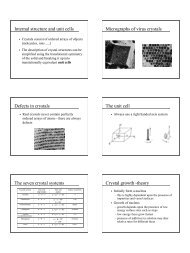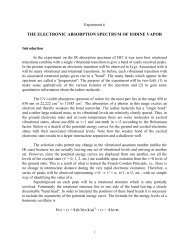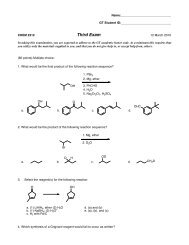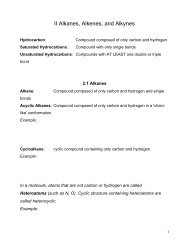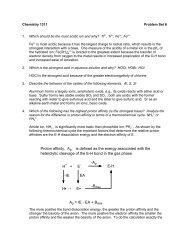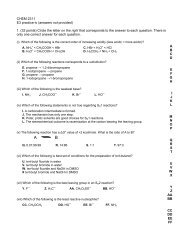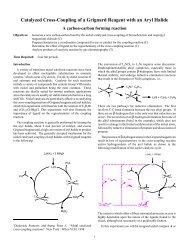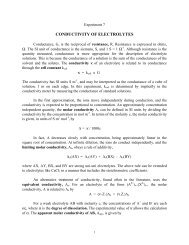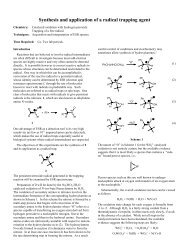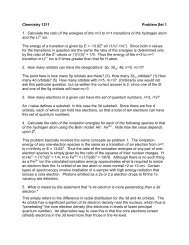Interpreting atomic coordinates Atomic connectivity The calculation ...
Interpreting atomic coordinates Atomic connectivity The calculation ...
Interpreting atomic coordinates Atomic connectivity The calculation ...
Create successful ePaper yourself
Turn your PDF publications into a flip-book with our unique Google optimized e-Paper software.
<strong>Interpreting</strong> <strong>atomic</strong> <strong>coordinates</strong> A crystal structure refinement leads toestimates of model parameters– <strong>coordinates</strong>, temperature factors andoccupancies What matters chemically is <strong>atomic</strong><strong>connectivity</strong> (bonding) and packing Need inter<strong>atomic</strong> distances and structuraldrawings<strong>Atomic</strong> <strong>connectivity</strong> Inter<strong>atomic</strong> distances can be used todetermine the presence of bonds– chemical bonds often lead to well definedinter<strong>atomic</strong> distances»Csp 3 -C sp 3 ~ 1.53A»Csp 2 -Csp 2 ~ 1.32A Distances are readily calculated from<strong>atomic</strong> fractional <strong>coordinates</strong><strong>The</strong> <strong>calculation</strong> of bond lengths Position of atom in unit cell– r =xa +yb +zc Vector between two atoms– r = xa + yb + zc Calculate length from In most space groups there is more than onesymmetry equivalent of an atom in the unitcell– you need to take this into account whencalculating bond lengths– r.r = |r| 2 Symmetry equivalent atomsBenzene Space group Pbca. Each molecule has itscenter at an inversion centerErrors on bond lengthsRefinement give estimate of errors on x,y,z– this information can be used to estimate errors onderived quantities such as bond lengthsFor two atoms each with a positional standarddeviation of 0.005A– bond length = [0.005 2 + 0.005 2 ] 1/2– assumes <strong>atomic</strong> positions are not correlatedBond length <strong>calculation</strong> programs take intoaccount correlations
Structural diagrams Many different types– ball and stick (PLUTO)– thermal ellipsoids (ORTEP)– coordination polyhedra (STRUPLO) Many different styles– perspective– projection–stereoORTEP ORTEP plots are standard for smallmolecules. <strong>The</strong> orientation and size of theellipse tells you about the presence ofthermal motion, static disorder, and errorsin the model.ORTEP plotsCoordination polyhedraMonoclinicZrMo 2 O 8TrigonalZrMo 2 O 8Bond valence sumsBond strength - bond length In general there is a correlation betweenbond length and bond strength Pauling recognized that for some types ofstructure you could associate a valence witheach ‘bond’ between a central atom and itsneighbors and that these bond valenciesshould sum to give a number equal to the<strong>atomic</strong> valence of the central atom
Brown’s work I.D. Brown developed the bond valencesum idea– analysis of databases allowed the determinationthe relationship between bond length and bondvalence for a given pair of atoms– bond valence s ij = exp(r 0 -r ij /B)»r 0 and B are parameters from data base analysis»r ij is experimentally observed inter<strong>atomic</strong> distance <strong>The</strong>y can be used to check the accuracy of acrystal structure <strong>The</strong>y can be used to locate missing atoms <strong>The</strong>y have been used aids to structuresolution– <strong>atomic</strong> valence V i = s ijUse of bond valence sums




